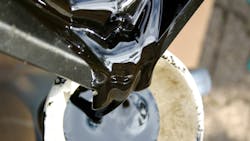No one likes it when a machine goes down. Maybe you noticed some small problem before but didn’t think much about it: a noise that didn’t belong, a slight drop in speed or an increase in temperature. Although hydraulic fluid is designed to last almost indefinitely, impurities such as water, dirt and metal scrapings significantly affect its performance.
Considering the number of laws and regulations regarding the disposal of hydraulic fluids, it’s important companies have proactive approaches to its proper use to reduce replacement and disposal costs. As green practices become more important to end-users, having proactive plans for maintaining the quality of hydraulic fluid is essential. The National Institute of Standards and Technology noted in 2015 that “Technology and social media let buyers easily (and publicly) promote or criticize companies for their green practices, or lack thereof.” Green practices attract new customers and increase sales, while not having them can chase them away.
According to ISO 4406, “Contamination is the single greatest cause of oil degradation.” It is also a commonly used indicator of component life. It is widely known that systems with high levels of contaminants have shortened life spans due to corrosion, oxidation and machine wear.
Contamination and Hydraulic Pumps
When water and particulates find their way into hydraulic fluid, they change its chemical and physical properties. Hydraulic fluids are formulated for specific applications and any changes can cause higher levels of mechanical wear and poor system performance. Such changes untimely lead to the death of your equipment due to unnecessary scoring and abrasion.
Contaminants enter hydraulic systems in several ways and come in different forms. Here’s some of the most common:
Built-in contaminants. This is the stuff left behind when the pump was manufactured. It consists of dirt, metal burrs and chips, and cloth fibers. Most manufacturers have contamination limits in place that define the allowed volume-to-area ratio of contaminants. The assembled pump is typically tested for contaminants, flushed, and sealed before the unit is shipped.
Ingressed contaminants. Contamination also happens after the pump is up and running. Dirt, ash and soot can enter pumps through worn seals or improperly filtered breather ports. Although airborne particles may not seem like a big issue, they can become one if given unrestricted access to a hydraulic system. There are lots of particulates floating around in the air in dusty or smoky work environments. Over weeks and months, that builds up in hydraulic fluid.
Contaminants also enter pumps when they are being serviced in the field. If a disconnected hose falls into the dirt and then gets reconnected without proper cleaning, the resulting contamination can be a problem. Additionally, new oil can introduce contaminants if it has been improperly stored or handled.
To keep contaminants out, parts should be handled carefully during maintenance. Consider filtering new oil before pouring it into the system to catch contaminants before they go into the machinery. And inspect and replace hoses, O-rings and seals often to keep particles from breaking off and entering the system.
Water contamination. Water and moisture will turn hydraulic fluid cloudy and react with additives to form corrosive byproducts. Water is a poor lubricant, so it tends to also reduce film-strength, decreasing hydraulic fluid’s viscosity and leaving surfaces vulnerable to corrosion and wear. Water also creates sludge that clogs filters, jets and nozzles and leads to oxidation as metallic wear debris is mixed with any water present.
Water infiltrates hydraulics several ways. Missing or cracked seals can let in water ingress, as can any open gasket or broken rod seal on a cylinder. If you live in a humid part of the country, water can condense inside from exposure.
To remove water from hydraulics, add desiccant breathers and filters. They will also remove water from the reservoir. Unfortunately, this hardware does nothing to capture water mixed with your oil; they only pull out freely circulating water. A second option is to change the oil, but this can lead to disposal issues. A better option is to keep oil dry through proper maintenance.
Protecting Hydraulics
A contamination control strategy should be part of your everyday operation, and all employees should be trained to properly handle and maintain hydraulic systems. This includes: • Properly storing oil in a climate-controlled location • Inspecting machines often and making repairs when needed • Protecting against contamination by filtering new oil • Monitoring oil condition on a regular basis • Observing best practices to keep water and contaminants from entering system.
Marla Keene is a technology writer for AX Control Inc.
About the Author
Marla Keene
Technology Writer, AX Control Inc.

Leaders relevant to this article:
